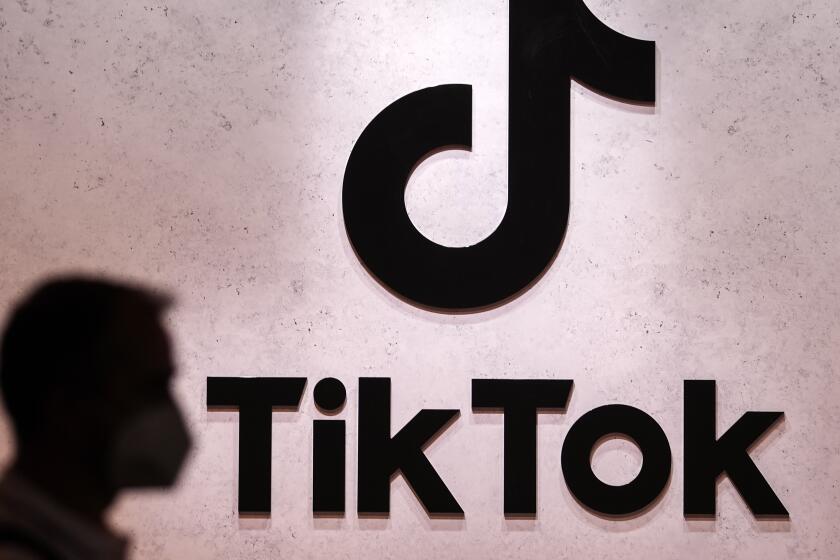Advertisers Mobilize to Tap Hand-Held Market
From billboards to banners on the Internet, advertisers have used every conceivable space to grab consumers’ attention.
Now the marketers are taking the first tentative steps toward invading a small, but incredibly valuable, piece of real estate: the screens on wireless hand-held devices.
With fear of the competition darkening their hearts and visions of sales dollars dancing in their heads, executives from companies as diverse as distillers Brown-Forman Corp., Starbucks Corp., Jiffy Lube International Inc. and the Coca-Cola Co. are exploring the possibilities of going mobile. In the not-too-distant future, the businesspeople hope, location-sensitive cell phones and personal digital assistants will flash, beep and buzz as pre-screened customers pass by malls, retail outlets, bars, restaurants and movie theaters offering bargains.
“Wireless is a phenomenal opportunity for advertisers,” said Dave Shankman, vice president of marketing for New York-based Vindigo, a developer of Web navigation applications for hand-helds. “You can deliver a message to someone at the exact moment they are positioned to buy.”
Market trials of wireless advertising are underway. Yet like most things technological these days, the promise of wireless advertising eclipses the current reality. At this point, there are fewer than 1 million wireless Internet users in the United States, compared with about 150 million PC-based Internet users, according to the Yankee Group. As a result, the number of wireless users receiving advertising is “almost immaterial,” said Adam Zawel, a senior analyst at the Boston-based research firm.
But that’s likely to change over the next 24 to 36 months, according to Rachel MacAulay, an analyst at the Kelsey Group, a Princeton, N.J.-based research company. Cellular technology manufacturers and service carriers are poised to flood the consumer market with wireless application protocol, or WAP, technology, which allows mobile Web connections, she said.
By 2005, MacAulay predicts, there will be 111 million wireless Web users in the United States, compared with 200 million PC-based Web users. (The Yankee Group is even more bullish on wireless, predicting a jump to 177 million wireless users over the same period.) “All this will be a very good thing for advertisers,” MacAulay said.
Not only will affluent, tech-savvy consumers be able to use their mobile devices to communicate with each other, they also will be able to quickly call up ad-filled pages full of colorful text, data and streaming video, as well as access debit and credit card accounts to make purchases. “Wireless devices will be our new wallets and pocketbooks,” MacAulay said.
Kelsey estimates this should drive the value of wireless advertising and transactions from approximately $210 million today to nearly $17 billion over the next five years. Europe and Japan are ahead of the United States in adopting wireless technology. But new Federal Communications Commission rules requiring providers to be able to determine within 100 feet the location of a user for emergencies will greatly enhance the ability of servers--and therefore advertisers--to instantaneously determine the exact location of potential consumers.
“This technology will start slow, pick up steam and achieve mass adoption,” MacAulay said.
Analysts said they do not anticipate wireless providers offering users free Internet access in exchange for receiving ads. Instead, it’s more likely that those users who volunteer--or “opt in”--for ad-based service will receive such incentives as free handsets, air time, maps, stock quotes, daily diaries, airline miles, hotel stays and maybe even sports tickets.
Both Starbucks and Jiffy Lube are researching wireless advertising and promotion applications, executives affiliated with the companies said. And Coca-Cola said it intends to invest at least $100 million over the next five years developing systems allowing wireless users to receive coupons and promotions and use their devices to purchase soft drinks from cashless vending machines.
“Our fundamental belief is that wireless Web access will be a mass consumer medium like radio, TV and the Internet,” said Daren Tsui, chief executive of SkyGo Inc. a San Mateo, Calif.-based wireless interactive marketing firm. Indeed, more than half of the 1 billion cell phones expected to be in use worldwide by 2003 will be able to receive advertisements via the Internet, Tsui said, asserting that “advertising marketing will play a huge role.”
The transition to “m”--for mobile--business will be tricky, though.
Until the technology improves, advertisers will remain trapped within a slow-moving, unwieldy, drab medium. Ad pricing and effectiveness remain open questions, although it’s already quite clear that users sick of telemarketers and unwanted e-mail will dump cell-phone suppliers who allow wireless advertisers to send irrelevant or annoying wireless messages.
Then there’s the privacy issue.
Once up and running, wireless advertisers, service providers and participating Web sites will have the way, if not the will, to collect, cross-reference and archive users’ names, Social Security numbers, telephone numbers, credit information, social preferences, geographic routines and buying habits.
This could result in unwanted interruptions and invasions of privacy even greater than those already foisted on us by telephone telemarketers, PC mail spammers and e-commerce sites, said Jason Catlett, president of Junkbusters Corp., a Green Brook, N.J.-based privacy advocacy group.
Advertisers will even have the ability to track mobile users’ routine whereabouts by massaging data collected from cell towers. “That’s nothing but an around-the-clock electronic stalking profile,” Catlett said, adding that such information probably will be open to subpoena not only by government prosecutors, but by civil litigants--say, in divorce cases--as well.
Sure, wireless users could avoid being tracked by turning off their phones, Catlett said. But he said laws should be adopted and systems put in place so users don’t feel compelled to take evasive action.
“Even the most aggressive marketers have some concern that wireless advertising is very unappealing to consumers and that this might damage the uptake of this technology,” Catlett said.
Nevertheless, wireless advertising executives are well aware they could invite onerous government regulations and kill their industry in its cradle if they anger consumers by selling personal information to third parties or by peppering them with annoying messages, said Matt deGanon, chairman of K2 Design Inc., a New York-based wireless marketing firm.
When it comes to wireless users and the Web, he said, “Boy, you have to be respectful.”



